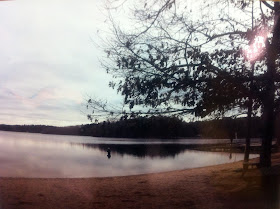So started a new routine for Monday mornings. This first Monday we shared why we chose our spots, and then made personal goals for how long we wanted to sit there without technology (they ranged from 10 minutes to 3 hours). Then, we taped our pictures along a row on a blank classroom wall. As spring progressed, the columns started to grow.
Our next week? To write while we were at our nature spots (we cut paper into quarter sheets, or they could write on any paper they liked). Ally drew while she was at hers as well, and her lovely sketches were put up with everyone's writing at the beginning of the next week.
Pretty soon April vacation came, and our goal was to visit our nature spots twice, 12 hours apart (preferably on the same day) so we could see how it changed. As creatures of habit, most of us went at the same time and on the same day, so this was an interesting way to mix it up. We saw different animals, heard different sounds, saw a different sky, and sometimes (at least in Sydney's case) got a completely different dose of weather.
Warning: make sure you go at comfortable times, Merry scared herself silly walking down the path at night, and Sydney ran into dubious police at dusk! Though, if I remember correctly, Dom enjoyed exploring the woods in the middle of the night.
Next, six-word memoirs while at our nature spots. These were inspired by a writing lesson on six-word memoirs we had done that week, and I was delighted with what everyone had to share. It was an authentic extension of a writing activity - I wish I could remember Robbie's (Robbie, if you read this, add it as a comment).
And thankfully, by this time, things were starting to grow! What beautiful flowers started appearing on our classroom wall (This classroom doesn't have any windows, so it was doubly nice to have fresh, colorful pictures appearing each week).
Wrapping up each Monday, students suggested what we do for the next week. Sometimes I would ask them to write or to draw, but sometimes their suggestions were much more fun than mine. Note: if you do nature spots in your class, some of us liked having a task each week while others liked the freedom to bring in what they wanted.
A definite favorite was the week we chose 'interaction with animals in nature' - thanks Serena! The rules were that you couldn't touch native animals, and that you couldn't disturb nature in general.
 For all the joy in living and springtime, we did have one quite morbid week. When we were merging Macbeth and poetry back in January, I had brought in an anthology of Japanese Death Poems - haikus written by Zen monks and haiku poets on the verge of death. We had written haikus from Lady Macbeth's point of view, and someone suggested we write death poems as if we were dying at our nature spots. Someone else suggested bringing in an object to memorialize their nature spots, and I said that was fine as long as it was not alive or previously alive (unless it was a leaf). The next Monday we dimmed the lights and stood in a circle and read our death poetry...
For all the joy in living and springtime, we did have one quite morbid week. When we were merging Macbeth and poetry back in January, I had brought in an anthology of Japanese Death Poems - haikus written by Zen monks and haiku poets on the verge of death. We had written haikus from Lady Macbeth's point of view, and someone suggested we write death poems as if we were dying at our nature spots. Someone else suggested bringing in an object to memorialize their nature spots, and I said that was fine as long as it was not alive or previously alive (unless it was a leaf). The next Monday we dimmed the lights and stood in a circle and read our death poetry...Honestly, it was one of the best ongoing units I have ever had the pleasure to teach. Not every student had something each week, but they owned up to it, or just shared their story (Tim was scratched by some vicious thorns one week, Kelsey convinced her brothers to hang out with her (or at least sit still while she took a picture) during 'bring a friend to your nature spot' week), and it was simply a nice way to begin second period every Monday.
If I had to justify it in teacher language, I would say it built writing, poetry, photography, and social skills, connected thematically to Fahrenheit 451, and provided a low-risk weekly public speaking opportunity.
If I were to recommend it in real language, I would say it was one of the most fun and authentic ways my students connected to me, each other, language, and nature, all in 15 minutes a week.









No comments:
Post a Comment